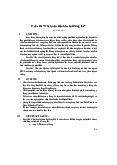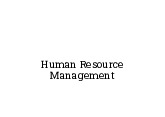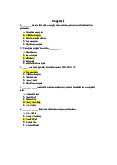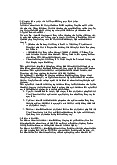



Preview text:
Deepwater in Deep Trouble
When all is said and done, which may not be for many years, it’s likely to be one of
the worst environmental disasters, if not the worst, in U.S. history.44 British
Petroleum’s (BP) Deepwater Horizon offshore rig in the Gulf of Mexico exploded in
a ball of flames on April 20, 2010, killing 11 employees. This initial tragedy set in
motion frantic efforts to stop the How of oil, followed by a long and arduous cleanup process.
Although the impacts of the explosion and oil spill were felt most intensely by
businesses and residents along the coast and by coastal wildlife, those of us inland
who watched the disaster unfold were also stunned and dismayed by what we
saw happening. What led to this disaster, and what should BP do to minimize the
likelihood of it ever happening again? One thing that has come to light in the
disaster investigation is that it’s no surprise that something like this happened.
After Hurricane Dennis blew through in July 2005, a passing ship was shocked to
see BP’s new massive SI billion Thunder Horse oil platform “listing precariously to
one side, looking for all the world as if it were about to sink.” Thunder Horse “was
meant to be the company’s crowning glory, the embodiment of its bold gamble to
outpace its competitors in finding and exploiting the vast reserves of oil beneath
the waters of the gulf.” But the problems with this rig soon became evident. A
valve installed backwards caused it to flood during the hurricane even before any
oil had been pumped. Other problems included a welding job so shoddy that it
left underwaters pipelines brittle and full of cracks. “The problems at Thunder
Horse were not an anomaly, but a warning that BP was taking too many risks and
cutting comers in pursuit of growth and profits.” Then came the tragic explosion
on the Deepwater Horizon. Before the rig exploded, there were strong warning
signs that something was terribly wrong with the oil well. Among the red flags
were several equipment readings suggesting that gas was bubbling into the well, a
potential sign of an impending blowout. Those red flags were ignored. Other
decisions made in the 24 hours before the explosion included a critical decision to
replace heavy mud in the pipe rising from the seabed with seawater, again
possibly increasing the risk of an explosion.
Internal BP documents also show evidence of serious problems and safety
concerns with Deepwater. Those problems involved the well casing and blowout
preventer. One BP senior drilling engineer warned. “This would certainly be a
worst-case scenario.” The federal panel charged with investigating the spill
examined 20 “anomalies in the well’s behavior and the crew’s response.” The
panel is also investigating in particular why “rig workers missed telltale signs that
the well was close to an uncontrolled blowout.” The panel’s final report blamed
both BP and its contractors for the failures that led to the explosion on the
Deepwater Horizon. Many of those failings stemmed from shortcuts to save time
and money. However, the report also faulted the government for lax oversight of the companies. Discussion Questions
14-38 What type(s) of control— feedforward, concurrent, or feedback— do you
think would have been most useful in this situation? Explain your choice(s).
14-39 Using Exhibit 14-2, explain what BP could have done better.
14-40 Why do you think company employees ignored the red flags? How could
such behavior be changed in the future?
14-41 What could other organizations learn from BP's mistakes? SUMMARY
The Deepwater Horizon oil spill occurred on April 20, 2010 when the BP oil
company's Macondo well blew out in mile-deep water in the Gulf of Mexico. The
explosion killed 11 workers and caused the Deepwater Horizon drill rig to capsize
and sink. It entailed a long and difficult cleanup process. It was the largest spill of
oil in the history of marine oil drilling operations.
The Deepwater Horizon oil spill caused 11 deaths, released over 130 million
gallons of crude oil into the ocean, and had a lasting impact on the Gulf Coast's
already compromised ecosystem. Studies have determined that oil is particularly
toxic for many species of larval fish, causing deformation and death. This incident
also put a strain on Deepwater’s reputation. ANSWERS
14-38. Feedback control would have been most useful in this situation. Feedback
control involves monitoring the results of a process and making adjustments to
ensure that the desired outcome is achieved. In this case, feedback control would
have allowed for the monitoring of Deep Water's performance and the
implementation of corrective measures to ensure that their goals were met.
14-39. Using 14-2 BP could have put in better controls before and after the
explosion, such as measuring their actual performance and running a test run of
the ship on its course. Additionally, they should have taken the potential dangers
of their drilling operation more seriously and planned for potential problems.
Company employees may have ignored the red flags due to a lack of awareness or negligence.
14-40. Company employees likely ignored the red flags due to pressure from the
company to complete the project within a certain amount of time. To prevent
such behavior in the future, companies should prioritize safety and ensure that
employees are not pressured into ignoring potential risks. Additionally, companies
should have clear protocols in place for reporting any potential risks or issues that
arise during a project. Moreover, BP was too fixated on profits and the company’s
growth, which was short-sighted and unsustainable.
14-41. Organizations can learn from BP's mistakes by understanding the financial
implications of reputational damage, the importance of internal communication,
and the need to prioritize safety over short-term gains. Additionally, organizations
should be aware of the consequences of negligence and ensure their crisis
communications efforts are well-prepared and executed. Finally, organizations
should remember lessons learned in order to avoid repeating costly mistakes.




